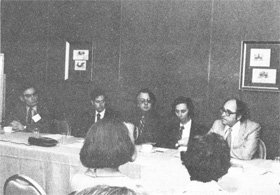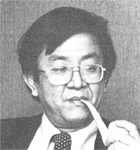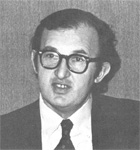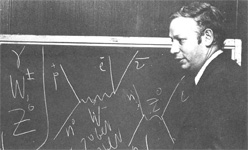APS/AAPT Meets in Chicago Area
The heavy migration of Fermilab professional staff to Chicago February 7-10 was due to the annual meeting of the American Physical Society being held there at the Palmer House, jointly with the American Association of Physics Teachers. Fermilab, in turn, opened its facilities for a tour by APS members on Tuesday, February 8, furthering the exchange between scientists that is the purpose of the meeting. Nearly 100 people joined that tour. Many informal tours were also arranged between professional colleagues during the week.
Nearly 600 scientific papers were presented on virtually all the major areas of physics research, application, and education in the four-day program. The results of experimental research done at Fermilab were presented by scores of scientists who have participated in the research program. Dr. John Peoples, head of the Fermilab Research Division, appeared in a symposium panel at the first session of the meeting together with Nicholas P. Samios of Brookhaven, R. Felst of DESY, Gerson Goldhaber of the Lawrence Berkeley Laboratory, and Jonathan L. Rosner, now at Princeton. Their session was titled, "The New Particles," and they described the exciting developments since 1973 in research on charmed particles. Peoples recounted the discovery of the charmed baryon at Fermilab announced last August. He also mentioned that the Saver/Doubler and colliding beam research projects at Fermilab will be important to the next generation of research.
Gerson Goldhaber of the Lawrence Berkeley Laboratory, mentor of many charm researchers, also looked to the future direction of charm. He mentioned that the PEP (Positron-Electron Project) at Stanford, with its new energy levels, may reveal other new quantum numbers like "charm."
Rosner (a frequent visitor in the Fermilab Theoretical Physics Department) said, "Still more charmed particles remain to be discovered. One of them -- a composite of the charmed quark c and the strange antiquark -- may be just around the corner... raise the possibility that a new neutral lepton could be among the decay products of this particle, and calculate the probability of its being observed as a function of the mass of the neutral lepton. This neutral lepton, as well as a charged heavy lepton for which there now seems to be strong evidence, can be very helpful in constructing the correct 'periodic table' of the quarks and leptons."
Explaining unified field theories to APS meeting
Theorist Steven Weinberg was awarded the 1977 Dannie Heineman Prize for Mathematics at the APS meeting. Weinberg read the citation to a press conference because, he said, "I am so proud of it: 'for his formulation of unified gauge theories of weak and electromagnetic interactions, and his analyses of the role of spontaneous symmetry breaking in such theories, all represented by outstanding publications in the field of Mathematical Physics.'"
Weinberg, Benjamin Lee, head of Fermilab's Theoretical Physics Department, and Charles Baltay of Columbia University, presented a symposium on the Tuesday program entitled, "Unified Gauge Theories and their Implications." Weinberg repeated his theory of the necessity for the existence of the so-called "Higgs Boson" particle in order to unify the weak and electromagnetic interactions, a theory he discussed at Fermilab a few months ago on a visit here as a guest speaker.
His theory is enhanced, he feels, by recent news from the Swiss Institute for Nuclear Research (SIN) of an experimental finding in which mu mesons decay into electrons and photons. "This has thrown the world community of theoretical physicists into a frenzy of speculation, calculation, and publication. One of the simplest and most natural possibilities is that this is another effect of the scalar particles...It remains to be seen whether these experimental results will hold up, and whether our explanation is the correct one," he said.
Dr. Lee discussed the mathematical confirmations of the Weinberg-Abdus Salam theories. Dr. Baltay disclosed his review of experimental results on weak neutral currents from several institutions in the world, as these results relate to the confirmation of the weak neutral current theories.
Photos taken at APS meeting, courtesy Dr. Gerald Present, American Institute of Physics.







